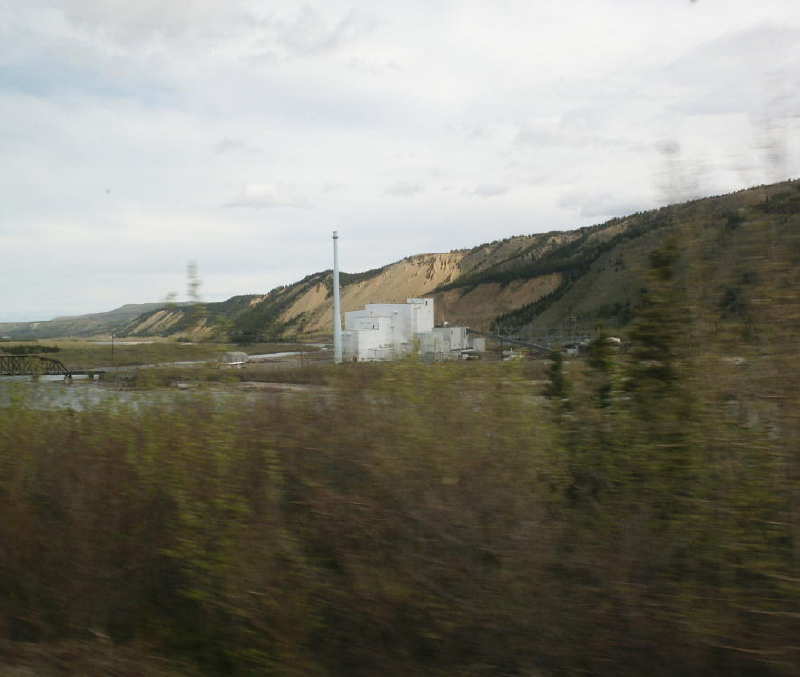
Fairbanks To Anchorage By Train









This was one of the many highlights of our Alaska trip. We were close enough to actually photograph Dall sheep (large white wild sheep of northwestern Canada and Alaska). Coupled with being able to see and photograph a mother moose and her calf on the way up to Fairbanks, this made the entire train trip very special. These are magnificent creatures. Better photos follow:

This is a mother Dall sheep and her offspring. Note that mother is on the alert.

This is perhaps more than you ever wanted to know about Dall sheep:
| Dall Sheep Fact SheetA Sheep of a Different Color: Dall sheep are typically all white in color, although a few black hairs on the tail are not uncommon. The white coat is an adaptation, or special trait that helps them survive. Dall sheep typically move to lower altitudes in the winter, but predators are more numerous there. The white coat helps the sheep go unseen against the snow by predators. In the summer months, their coat does not change color, but stays white. They are still protected, however, because they move to steep and rocky cliffs where predators are hard-pressed to follow. Spiraling Outward: Both rams (males) and ewes (females) have horns which continue to grow throughout the animals’ lives. Horns are different from antlers because horns are a slow-growing, permanent bone, covered by a thin sheath of hard, bony keratin. The entire horn (core and sheath) are never shed or “dropped” like antlers. Horns are usually not branched, but have massive bases and taper to fine tips. Ram horns grow continually in a spiral, but growth slows down during winter. The annual decrease of horn growth results in a pattern of rings along the horn called annual rings. A sheep’s age can be determined by counting these rings. Female horns are shorter, blunter, and grow in a gentle arc over the head. They also have annual rings. Rams frequently use their horns to fight during the breeding season. Hoofin’ It: All ungulates walk on hoofed toes. Hooves are made of keratin, which encases the toe bones. Dall sheep walk on two toes which places them in the “even-toed” group of ungulates similar to giraffes, deer, and camels. Hooves are another adaptation that enable Dall sheep to live on rocky, steep terrain. Their toes are flexible and able to adjust to the uneven surfaces in their mountain habitats where sure footing is essential. Eating Machines: Ungulates love to EAT! Dall sheep feed primarily on grasses and sedges. In the winter they actually eat frozen grass, stems, lichen, and moss. Sheep will often travel to mineral licks to eat soil. These are typically rocky outcrops where high concentrations of minerals are pooled. This replenishes essential minerals that the sheep cannot get from their daily diet of plants.Since they eat a variety of plants, sheep have developed special adaptations for their eating habits. They have lost their canine teeth but have developed large, flat cheek teeth with raised ridges. When chewing, the teeth move side-to-side and front-to-back in a triangular motion to grind food. Strong lips and tongue are designed to grab and tear foliage and other vegetation. Special stomach chambers allow ungulates to digest plant material. Ruminants, such as Dall sheep, have a complex stomach made up of four chambers. One chamber has bacteria that ferments the food and breaks down the plant material for absorption. After the food is fermented, the sheep regurgitates it and chews the food again. This second chewing is called rumination. After the second chewing, the food goes through the other three chambers and then to the intestines. It may take FOUR days to digest a meal completely! Super Senses: Like other ungulates, Dall sheep have well-developed senses. Their long noses are filled with olfactory nerves to help them detect predators. Large ears can rotate to detect sounds from all directions. Big eyes, set on the sides of their heads let them see in many directions at the same time.Loyalty and Safety: Dall sheep have well developed social systems. Adult rams live in bands, or groups, associated with ewe groups during the mating season. Since Dall sheep are very loyal to their social group, they have very specific home ranges (a geographic area where they normally live). After joining a social group, sheep are never known to leave it. One adaptation of living in a social group is safety from predators. With so many eyes watching for a sign of danger, a predator can be spotted sooner so the whole group can flee. |
Mother is still on the alert. Her offspring is trying to find something a little more appetizing to eat.


These are considered prize trophies by Alaskan hunters (and those who travel form all over the world to hunt in Alaska).

If you follow the ridge that starts at approximately the lower right corner of this photo upward toward the upper center of the photo you will be able to spot four more Dall sheep (just to the left of that clump of green trees). Following that same ridge all the way up to near the top of the photo you can make out one more Dall sheep. Also, straight up to near the top of top ridge above the four in the approximate center (first group) you will be able to see another white spot. That is another Dall sheep. I believe that to be the ram. It is amazing that we were able to see so many of the great animals in one place at one time. They are usually very elusive. Our cup ran over right here on the Alaska Train from Fairbanks to Anchorage. You must take this ride.

























Related Posts
Anchorage; Wandering About
Inside The Kennicott, Photos by Jan
Anchorage; Visiting Unusual & Unique Places
More Inland Passage And A Larger Village
Some Mighty Fine Folks And Some Mighty Fine Country